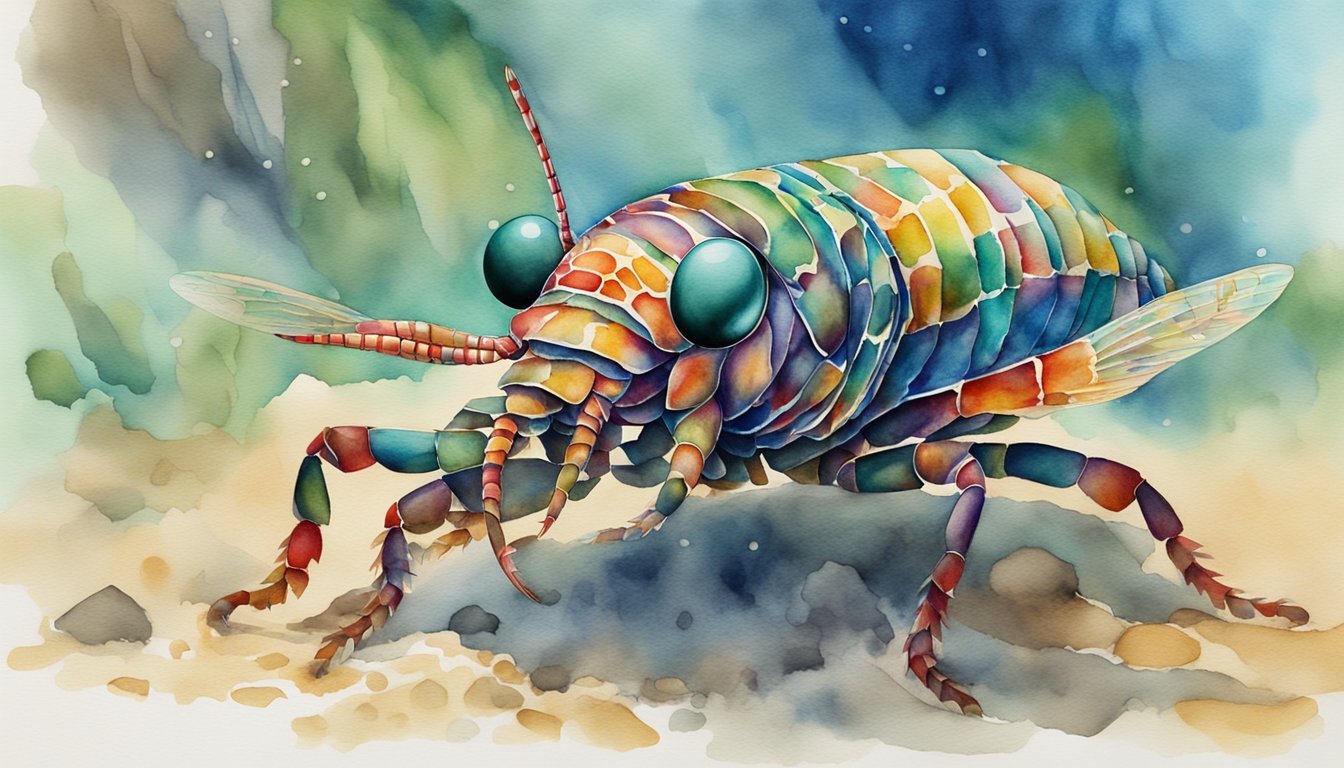Mantis Shrimp Overview
The mantis shrimp is a fascinating marine creature known for its vibrant colors and extraordinary vision. It is from the order Stomatopoda, a group of predators renowned for their hunting prowess and unique physical capabilities.
Species and Classification
Mantis shrimp are part of the class Malacostraca within the phylum Arthropoda, the largest phylum in the animal kingdom. This colorful creature belongs to the order Stomatopoda, which is distinct from other crustaceans due to its specialized predatory adaptations.
Physical Characteristics
An adult mantis shrimp typically measures around 10 cm in length but some species can reach up to 38 cm. Their body is covered in a range of colors from bright blues to greens and reds, adapted for camouflage and signaling. They possess trinocular vision with two large, compound eyes that can detect ultraviolet and polarized light.
Habitat and Distribution
Mantis shrimp are found in tropical and subtropical waters, commonly in the Indian and Pacific Oceans. Their habitats range from shallow coral reefs to deeper waters. Countries like Japan, Vietnam, the Philippines, and regions including Hawaii and the Mediterranean, are known for their mantis shrimp populations.
Behavior and Life Cycle
These creatures are known for being active and territorial. They often dig burrows in the seabed where they can stay hidden and ambush prey. The life cycle of mantis shrimp includes laying eggs which hatch into larvae; these larvae then develop into the colorful adults. Some species are monogamous, staying with one partner and caring for their eggs together.
Conservation and Human Interaction
Most species of mantis shrimp are not considered endangered, but they are sometimes collected for aquariums. However, due to their strong smashing abilities, they can break aquarium glass. In some cultures, mantis shrimp are also sought after for their culinary value.
Mythical Comparison
The mantis shrimp is sometimes likened to a praying mantis due to its raptorial claws, earning it nicknames like “thumb splitter” and “prawn killer.” This marine crustacean also shares similarities with mythical creatures due to its exceptional attributes and dramatic hunting techniques.
Unique Traits and Abilities
This stomatopod is either a “smasher” or “spearer,” based on its raptorial claws used for hunting. Smashers possess calcified clubs to smash hard-shelled prey at incredible speeds, causing cavitation bubbles. Spearers, on the other hand, have sharp appendages for spearing soft-bodied prey.
Role in the Ecosystem
Mantis shrimp play a crucial role in the ecosystem as predators, controlling the populations of their prey which includes fish, crabs, mollusks, and other invertebrates. Additionally, their burrows can provide shelter to other sea life and contribute to the structure of the seabed.
Diet and Hunting Techniques
Their diet consists of a variety of hard-shelled prey such as crabs, lobsters, snails, and mollusks. The mantis shrimp has developed two main techniques for hunting: smashing and spearing, both of which are effective and display the creature’s superb predatory adaptations.
Reproduction and Development
Mantis shrimp are often monogamous and share the duty of guarding their eggs. These eggs hatch into larvae, which eventually metamorphose into adults. The mantis shrimp can have a significant lifespan with some living together with their partner for up to 20 years.
Discover more about their unique vision and color perception, get insights into their dietary preferences, or learn about their role in various cuisines around the world.
Mantis Shrimp Interaction with Humans

The relationship between mantis shrimp and humans is multifaceted, involving aspects that range from the creature’s role in aquariums to its impact on culture and economy. Their unique characteristics also spur significant interest in scientific communities.
Mantis Shrimp in Aquariums
They are sometimes kept as pets in aquariums due to their vibrant colors and fascinating behavior. However, mantis shrimp require special care because they can break standard aquarium glass with their powerful claws. Aquarium enthusiasts must use reinforced glass to prevent escape and damage.
Scientific Research and Studies
Mantis shrimp are subjects of scientific research due to their exceptional color vision and depth perception. Their eyes are far more complex than humans, having the ability to see polarized light and multispectral images. This research can lead to advancements in camera and optical technologies.
Cultural and Economic Impact
In some countries, mantis shrimp are an important part of the diet and have a significant cultural and economic impact. They are considered a delicacy and attract sightseeing to fish markets and restaurants in regions where they are commonly consumed.
Conservation Efforts
While mantis shrimp are not commonly known for being threatened, their role as a marine crustacean is crucial for the ecosystem. Efforts in conservation focus on maintaining their habitat to ensure that both the mantis shrimp and other species in their environment are protected.

